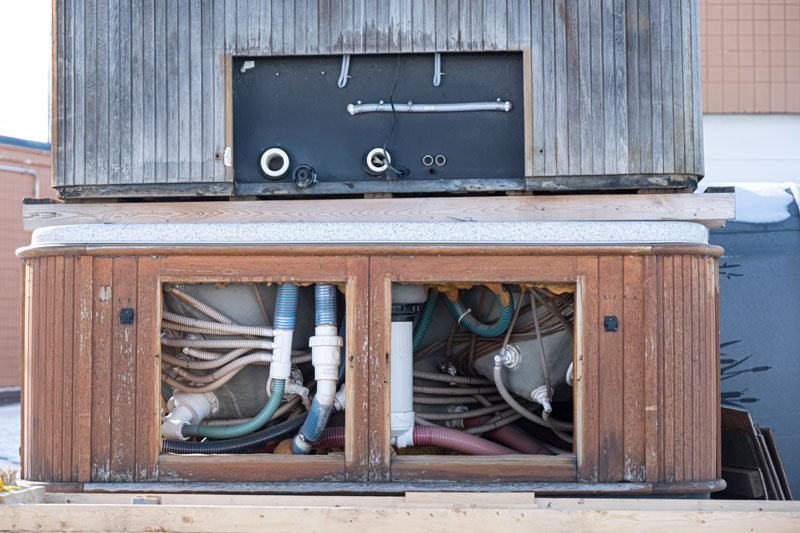Discover How Inground Spas Relieve Lower Back Pain
Key Takeaways
- Inground spas can alleviate lower back pain by using warm water therapy and buoyancy effects.
- Choosing the right spa size, depth, and jet placement is essential for maximum comfort and effectiveness.
- Regular spa routines paired with physical therapy and proper accessories further enhance pain relief.
- Professional advice helps tailor treatments to individual needs for long-lasting benefits.
Understand the Benefits of Inground Spas for Back Pain Relief
Inground spas offer a unique solution for homeowners seeking relief from lower back pain through therapeutic warm water treatments delivered in the comfort of their own yard. In recent years, the evolution of spa design has led to the rise of modern-inground-spas, which blend advanced features with the classic appeal of traditional inground spas—sometimes even incorporating design elements reminiscent of cocktail-pools. The combination of gentle hydrotherapy and buoyancy helps relax muscles, improve circulation, and reduce strained pressure on the spine. This section describes how the inherent features of these spas make them a compelling option for back pain management.
Recognize How Warm Water Soothes Muscle Tension and Discomfort
Warm water in an inground spa increases local blood flow and stimulates relaxation. The heat penetrates deep into muscle fibers, reducing tension and easing spasms often associated with chronic back pain. Regular use can help lessen the severity of muscle stiffness, promoting an overall sense of comfort. Studies have shown that exposure to warm water therapy allows muscles to relax faster, thereby reducing pain and enabling a more active lifestyle.
Learn About Targeted Hydrotherapy and Its Healing Effects
Targeted hydrotherapy in these spas directs controlled water jets at specific muscle groups to relieve pain and promote healing. The pulsating water pressure helps to massage the lower back, encouraging microcirculation and the removal of metabolic waste from stressed tissues. Additionally, this technique stimulates nerve endings, supporting improved flexibility and faster recovery in injured or overtaxed areas of the back.
Discover the Role of Buoyancy in Reducing Spinal Pressure
Buoyancy provided by the water in inground spas plays a crucial role in alleviating spinal pressure. When the body is immersed, it experiences a reduction in weight bearing on the spine. This reduction allows the vertebrae and surrounding muscles to rest and recover from the stresses of daily activities. Users often report decreased discomfort and a noticeable improvement in mobility after routine sessions, making buoyancy a significant factor in pain management strategies.
Choose the Right Inground Spa for Your Needs
Selecting an appropriate inground spa is vital for ensuring that it meets the specific therapeutic needs of a homeowner. The right combination of shape, size, and technical features can enhance the overall benefits and provide tailored pain relief. Homeowners should consider various factors such as spatial dimensions, water depth, and the performance of water jets before making a decision.
Evaluate Size and Depth to Accommodate User Activities
A spa’s size and depth impact both comfort and the effectiveness of hydrotherapy. For optimal lower back relief, the spa should be deep enough to allow full-body immersion while enabling the user to position themselves comfortably. A spacious design ensures that individuals can stretch out, perform light exercises, or simply relax without feeling confined, contributing positively to the therapeutic process.
Assess Jet Placement for Maximum Pain Relief Effectiveness
The placement and strength of water jets are essential features in an inground spa. Strategically positioned jets can target the lumbar region directly, providing a focused massage that minimizes tension and pain in problematic areas. Homeowners should test different jet configurations to find a model that best addresses their specific discomfort, ensuring a more personalized pain management experience.
Compare Materials for Durability and User Comfort
Inground spas come constructed from various materials such as fiberglass, concrete, or composite blends. Each material type offers its own benefits in terms of heating efficiency, durability, and aesthetic appeal. Fiberglass models tend to be easier to maintain and offer smooth, comfortable surfaces, while concrete provides flexibility in customization. Homeowners must weigh these factors against budget and design preferences to select a spa that guarantees long-term performance and effective pain relief.
Implement a Regular Spa Routine for Effective Pain Management
A consistent spa routine can markedly enhance the benefits of inground spas when addressing lower back pain. Establishing a regular schedule helps the body acclimate to therapeutic water treatments, leading to cumulative improvements in muscle relaxation and spinal health over time. Integrating stretching exercises and vigilant symptom tracking further supports this process.
Create a Schedule for Consistent Use to Achieve Results
Setting aside dedicated time for spa sessions establishes a healthy routine essential for therapeutic progress. Homeowners should aim for regular sessions—ideally several times a week—where the soothing effects of warm water can be maximized. Consistency not only improves the immediate pain relief experience but also contributes to long-term benefits such as enhanced mobility and reduced inflammation in the lower back.
Incorporate Stretching Exercises Before and After Sessions
Complementing spa use with pre- and post-session stretching can enhance the overall benefits of the therapy. Gentle stretches prepare the back muscles for heat application and jet massage, while post-session exercises help maintain the improved range of motion and flexibility. Together these routines actively support recovery and make the spa treatment more effective in alleviating persistent back pain.
Track Symptoms to Monitor Progress and Adjust as Needed
Keeping a record of back pain symptoms, duration, and intensity enables homeowners to assess the effectiveness of their spa routine. Whether through a written journal or a digital tracking tool, monitoring changes over time can help users understand which aspects of the treatment provide the best relief. This documentation also assists in making informed decisions about adjusting session frequency or integrating additional therapeutic practices.
Combine Spa Use With Other Pain Relief Strategies
In addition to the standalone benefits of inground spas, combining spa use with complementary pain relief strategies can further improve outcomes. Integrating physical therapy, massage techniques, and posture correction methods creates a holistic approach for those battling chronic lower back pain.
Integrate Physical Therapy Techniques With Spa Benefits
Physical therapy exercises provide structural support to the lower back while increasing strength and flexibility. When these exercises are integrated with spa sessions, the warm water helps relax muscles before targeted rehabilitative stretches take place. This combined approach not only enhances immediate comfort but also contributes to long-term improvements in spinal alignment and muscle balance.
Utilize Massage Therapy to Enhance Relaxation and Recovery
Massage therapy, when used alongside regular spa use, can significantly augment the benefits of hydrotherapy by further reducing muscle tension and stimulating circulation. Professional massage treatments focus on releasing deep-seated knots and trigger points that may not be fully addressed by water jets alone. The dual approach can lead to a deeper state of relaxation, allowing the nervous system to reset and the body to recover more efficiently.
Explore Ergonomics and Posture Improvement for Lasting Relief
Correcting ergonomic setups and improving posture plays an essential role in lower back pain management. Spas complement these strategies by alleviating pain during recovery sessions, while ergonomic adjustments (such as proper seating and desk arrangements) provide lasting improvements throughout the day. Homeowners should consider integrating posture education tools or working with occupational therapists to achieve steady progress in reducing long-term back stress.
Consider Accessories to Enhance Spa Experience
Enhancing an inground spa installation with thoughtful accessories can transform a standard spa into a multifunctional retreat designed for maximum comfort and efficiency. Accessories not only boost the overall user experience but also ensure safety and ease of use, contributing to a more satisfying and therapeutic session.
Invest in Spa Steps for Safe and Easy Access
Safe and convenient access to the spa is paramount, especially for regular users managing back pain. Integrating well-designed spa steps allows for a secure entry and exit, minimizing strain and the risk of slips. High-quality steps made from durable materials provide both stability and aesthetic appeal, blending seamlessly with the spa’s design.
Use Spa Covers to Maintain Water Temperature and Cleanliness
A well-fitted spa cover is crucial for maintaining the optimum temperature of the water as well as for keeping the spa free of debris. By reducing heat loss and protecting the interior from external contaminants, a quality cover ensures the spa operates efficiently while also extending its lifespan. This accessory enhances the overall user experience by providing cost-effective and energy-efficient benefits.
Explore Lighting Options for a Calming Atmosphere
Ambient lighting options such as LED lights, underwater illuminations, or decorative fixtures contribute significantly to the soothing environment of a spa setup. Appropriate lighting can transform the space into a relaxing retreat, lifting the mood and further reducing stress. Moreover, adjustable lighting allows users to tailor the ambiance to their specific relaxation needs, promoting a tranquil atmosphere that supports overall wellness.
Get Professional Advice on Spa and Pain Treatment Options
For homeowners investing in an inground spa as a tool for pain management, seeking professional advice is essential. Experts can provide tailored recommendations that align with individual health needs, ensuring that the chosen therapy effectively addresses underlying issues. Consulting both medical professionals and spa specialists contributes to a more informed and safer implementation of spa treatments.
Consult With a Doctor Before Starting a New Wellness Routine
Before integrating inground spa sessions into a treatment plan for lower back pain, it is advisable to consult with a healthcare provider. A doctor can evaluate any preexisting conditions and recommend modifications based on personal health history. Professional advice ensures that the spa routine is safe and compatible with an individual’s overall wellness strategy, minimizing risks and optimizing benefits.
Seek Guidance From a Spa Expert for Personalized Recommendations
Engaging with a spa expert can provide additional insights regarding the ideal spa configuration and accessory options. These professionals bring expertise on the latest technological advancements and user-specific customization, ensuring that homeowners select a system engineered to maximize therapeutic outcomes. Personalized recommendations help to fine-tune the treatment protocol and deliver coherent results that align with specific pain management goals.
Attend Workshops or Classes Focused on Spa Techniques and Benefits
Ongoing education is a key component of any health regimen. Workshops or classes that focus on spa techniques provide users the opportunity to learn best practices, understand the science behind hydrotherapy, and receive practical advice on integrating spa use into a broader wellness program. Such sessions can offer valuable insights on how to modify routines, troubleshoot issues, and continually improve the effectiveness of the treatment.
Frequently Asked Questions
Q: How quickly can inground spas alleviate lower back pain? A: Many users experience reduced pain and muscle tension after just a few spa sessions, though consistent use over several weeks is recommended for optimal, long-lasting benefits.
Q: Are there any age restrictions for using an inground spa for back pain relief? A: Inground spas are generally safe for adults of most ages; however, individuals with severe back conditions or other health concerns should consult their healthcare provider before beginning any hydrotherapy routine.
Q: What maintenance is required for an inground spa to remain effective? A: Regular cleaning, proper chemical balancing, and routine checks on components such as pumps and filters are essential to maintain optimal performance and therapeutic benefits.
Q: Can inground spas be combined with other treatments for back pain? A: Yes, combining spa sessions with physical therapy, massage, and ergonomic adjustments can provide a comprehensive approach to back pain management.
Q: How do I choose the right features on an inground spa for my specific needs? A: Look for spas with adjustable jet settings, appropriate depth and seating, and quality materials. Consulting with spa experts and reviewing product specifications can greatly assist in making the right choice.




 No products in the cart.
No products in the cart.